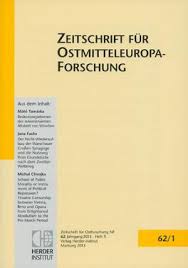Die griechisch-katholische und die orthodoxe Konfession als Instrument nationaler Politik im Lemkenland in Polen 1918-1939
The Greek Catholic and Orthodox Confessions as Instruments of National Policy in the Lemkivshchyna in Poland (1918-1939)
Author(s): Bernadetta Wójtowicz-HuberSubject(s): Political history, Politics and religion, Pre-WW I & WW I (1900 -1919), Interwar Period (1920 - 1939), Eastern Orthodoxy
Published by: Verlag Herder-Institut
Keywords: Greek Catholic and Orthodox Confessions; Instruments of National Policy; Lemkivshchyna in Poland (1918-1939);
Summary/Abstract: After the failure and fall of the Lemko Republic (1918-1921) the focus of Lemko community life shifted to the confessional level. The politicisation of the religious sphere, the equation of the Greek Catholic faith with Ukrainian nationalism, and of Orthodoxy with the Russophile orientation, allowed the Polish authorities to use the churches for their own nationality policy. The government saw the Greek Catholic Church, which operated under Vatican protection, as a greater threat than the Orthodox Church, which had come under state control after the First World War. Therefore the Polish government also remained neutral regarding the increasing conversions to Orthodoxy in the Lemko region from 1926 onwards, and treated these as a counterweight to the Greek Catholic Church, which was seen as a repository of Ukrainian nationalism. At the same time however, the Polish authorities had no interest in the Orthodox Church gaining too much ground in the region and thus in the early 1930s they supported a Uniate jurisdiction independent of the Przemysł Diocese in the Lemkivshchyna. The sphere of jurisdiction of the new Lemko Apostolic Administration (LAA), founded in 1934, largely embraced a population without a clear sense of identity, and the later authorities relocated its administrative centre further east (from Rymanów to Sanok) in an attempt to neutralise Ukrainian influences in the eastern part of the region. The LAA proved useful as an instrument of Polish national policy in the inter-war period, allowing the Polish authorities to put pressure on Lemko church leaders. By Józef Piłsudki’s death in 1935 or even before, the previous policy of “state assimilation” was replaced with one of “national assimilation”, aiming to incorporate the Lemko people fully into Polish culture. The internal political course adopted by the new and increasingly strong military was directed at both the Greek Catholic and the Orthodox Churches’ spheres of influence, leading to the grave disappointment of members of both structures. Among the Ukrainian Lemko population this Polonisation policy aroused an indifferent and even hostile attitude to the Polish state, thus contributing to its weakening both before and during the Second World War.
Journal: Zeitschrift für Ostmitteleuropa-Forschung
- Issue Year: 62/2013
- Issue No: 2
- Page Range: 319-343
- Page Count: 25
- Language: German

